- Most newcomers to Denver come from within Colorado, particularly the surrounding metropolitan area. Outside of Colorado, many other new residents come from more expensive counties that include major cities like Los Angeles and New York.
- Increasing housing costs, especially rents, have pushed some Denverites into more affordable counties surrounding the city of Denver and throughout the United States.
- Denver is increasingly becoming a renter city, with a growing share of its population made up of both millennials and retirees.
The pace of population growth in the city of Denver is suitably Rocky Mountain high, boasting a trajectory over the past decade that is both uniform and enviable. But a deeper look at Denver’s recent growth trends reveals a number of seeming contradictions in one of America’s fastest-growing cities:
- The city is attracting new residents from all over the country, but the majority are coming from areas much closer to home.
- Of those coming from other large American cities, many are likely attracted by the relative affordability of Denver – even as long-time residents are getting priced out and pushed to live outside city limits.
- Local rental affordability has suffered greatly in recent years, but the city now has more renters than homeowners.
- And all the while, new jobs and low unemployment, combined with Denver’s long-established natural beauty and livability, are attracting droves of new residents both young and old.
Using county-level household migration data from the Internal Revenue Service, Zillow analyzed households that moved both to and from Denver in 2013 (the most recent year for which data is available). We compared housing affordability in Denver and in the counties where movers to Denver originated, and movers from Denver ended up.[1] To get a better picture of the changing population, we supplemented this analysis with data from the U.S. Census Bureau.
Growth from Near and Far
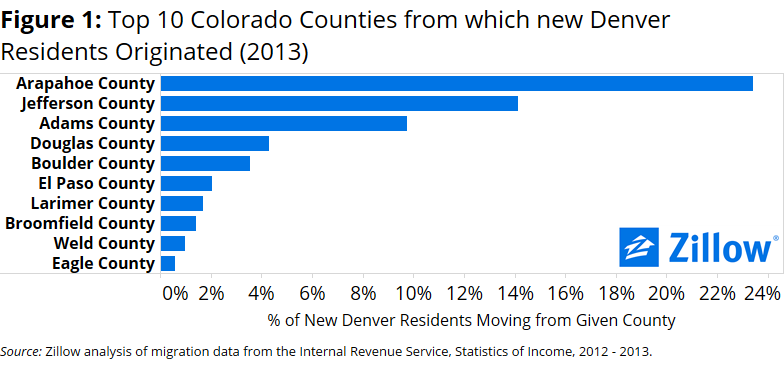 In the decade from 2004 through 2014, the overall population of the larger Denver metro area grew by more than 430,000 residents, or more than 18 percent, according to the Census Bureau. The city of Denver itself added more than 15,000 residents in 2013 alone – roughly 3.5 percent of total growth experienced in the Greater Denver area between 2004 and 2014. And the majority of these new movers to the city of Denver in 2013 came from nearby – 65.3 percent of new movers to the city of Denver in 2013 came from other Colorado counties, especially from the nine counties outside the city of Denver that comprise the larger Denver metro area (figure 1).
In the decade from 2004 through 2014, the overall population of the larger Denver metro area grew by more than 430,000 residents, or more than 18 percent, according to the Census Bureau. The city of Denver itself added more than 15,000 residents in 2013 alone – roughly 3.5 percent of total growth experienced in the Greater Denver area between 2004 and 2014. And the majority of these new movers to the city of Denver in 2013 came from nearby – 65.3 percent of new movers to the city of Denver in 2013 came from other Colorado counties, especially from the nine counties outside the city of Denver that comprise the larger Denver metro area (figure 1).
For example, movers from Arapahoe County, located just east of the city of Denver and home to the large suburb of Aurora, represented 23 percent of all residents that moved to Denver in 2013. Movers from Jefferson County to the immediate west of the city of Denver which includes the city of Lakewood, represented 14 percent of all newcomers to Denver in 2013.
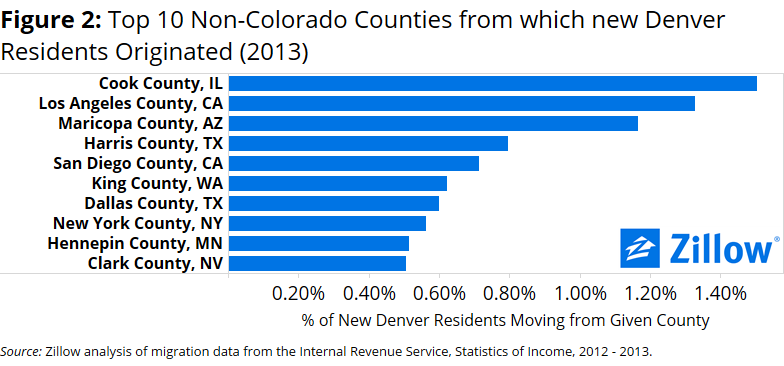 But while the majority of new movers to the city of Denver moved from neighboring areas, Denver has still proven very attractive to new residents from other parts of the country. Of all new movers to Denver in 2013 that didn’t come from Colorado, those from the Chicago, Los Angeles, Phoenix, Houston and San Diego areas represented the largest shares (figure 2).
But while the majority of new movers to the city of Denver moved from neighboring areas, Denver has still proven very attractive to new residents from other parts of the country. Of all new movers to Denver in 2013 that didn’t come from Colorado, those from the Chicago, Los Angeles, Phoenix, Houston and San Diego areas represented the largest shares (figure 2).
Affordability: It’s all Relative
There are a number of reasons why new residents might be flocking to the city of Denver, including abundant job opportunities and, for many, a relatively affordable cost of living. Those moving to Denver from cities like Los Angeles and New York – particularly renters – will find housing in the mile-high city to be a downright bargain compared to where they’re coming from.
In 2013, the typical renter in the city of Denver could expect to spend 37.4 percent of his income on rent, compared to 56.1 percent in New York County (essentially the island of Manhattan) and 48 percent in Los Angeles County (basically the city of L.A.).
But affordability in Denver is relative, and the rising cost of housing in the city is simultaneously pushing many existing Denver residents out of the city, even as it attracts others from more expensive locales. In 2013, the median home in Denver grew in value by 12.2 percent and median rent in the city grew by 10.8 percent. At the same time, median household income increased by just 1.2 percent in the city. Over the same period, national median home values grew by 7.4 percent and U.S. median rents grew by 3 percent – both healthy numbers in any period, but weak compared to Denver’s rapid housing appreciation. And that rapid appreciation, coupled with sub-par income growth, led many to flee the city of Denver in search of cheaper locales.
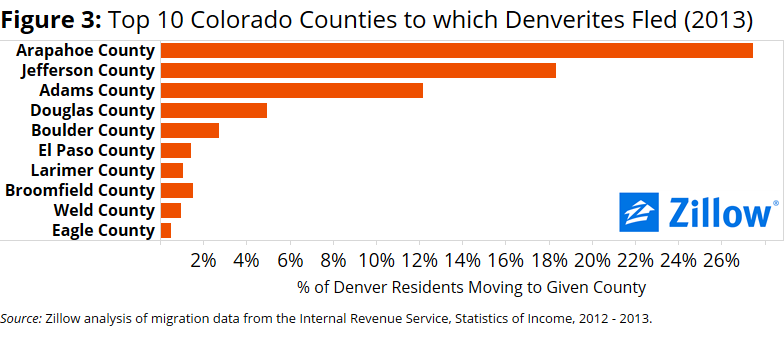 Of all Denverites who left the city in 2013, a large majority (81.9 percent) fled to counties with less expensive housing. But many wanted to stay close, with the bulk of those fleeing the city relocating to the surrounding, more affordable counties that make up the Greater Denver metropolitan area (figure 3).
Of all Denverites who left the city in 2013, a large majority (81.9 percent) fled to counties with less expensive housing. But many wanted to stay close, with the bulk of those fleeing the city relocating to the surrounding, more affordable counties that make up the Greater Denver metropolitan area (figure 3).
Renters, Young and Old
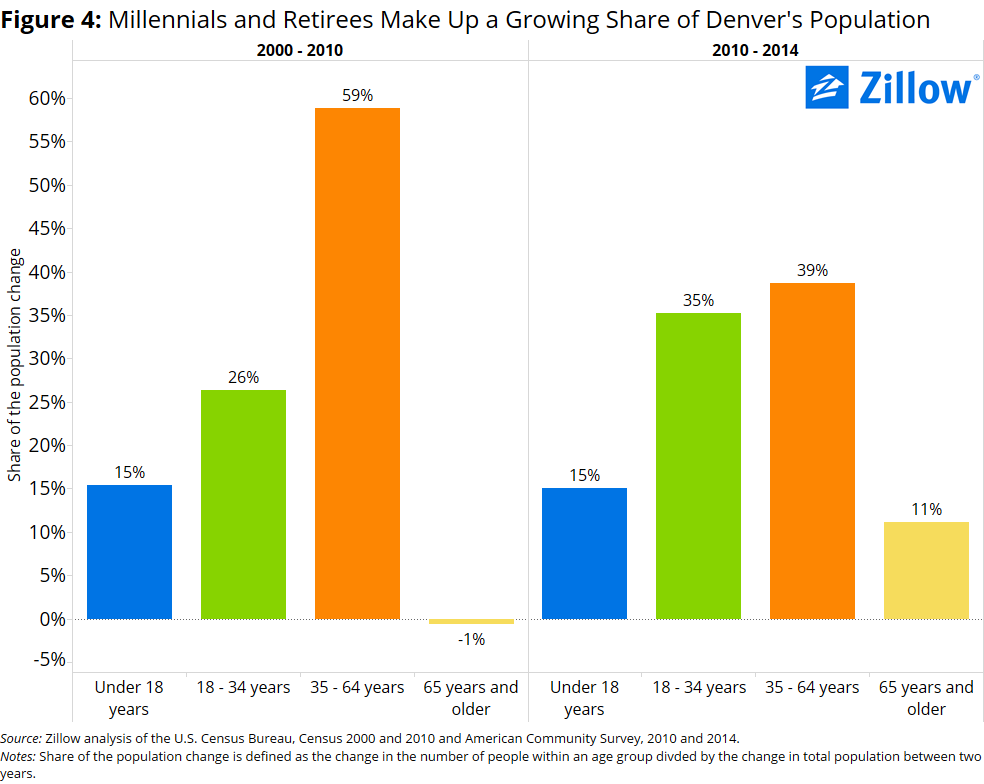 Denver has also become increasingly attractive to both young adults and their grandparents over the past few years. Between 2000 and 2010, those aged 18 to 34 years accounted for 26 percent of the population change in the city of Denver. Between 2010 and 2014, this age group accounted for 35 percent of the population growth in the city of Denver. Similarly, retirees – or those aged 65 and up – represented 11 percent of the total population growth in the city of Denver in the half-decade from 2010-2014. Between 2000 and 2010, Denver actually experienced a net loss in retirees (figure 4).
Denver has also become increasingly attractive to both young adults and their grandparents over the past few years. Between 2000 and 2010, those aged 18 to 34 years accounted for 26 percent of the population change in the city of Denver. Between 2010 and 2014, this age group accounted for 35 percent of the population growth in the city of Denver. Similarly, retirees – or those aged 65 and up – represented 11 percent of the total population growth in the city of Denver in the half-decade from 2010-2014. Between 2000 and 2010, Denver actually experienced a net loss in retirees (figure 4).
And like many other large and fast-growing cities attracting millennials and retirees, Denver is quickly becoming a renter-majority city. As recently as 2010, the homeownership rate in Denver was 52.5 percent. But by 2014, the gears had shifted, with the homeownership rate falling to 49.7 percent. In other words, more than half of the city’s households are now renting households (figure 5).
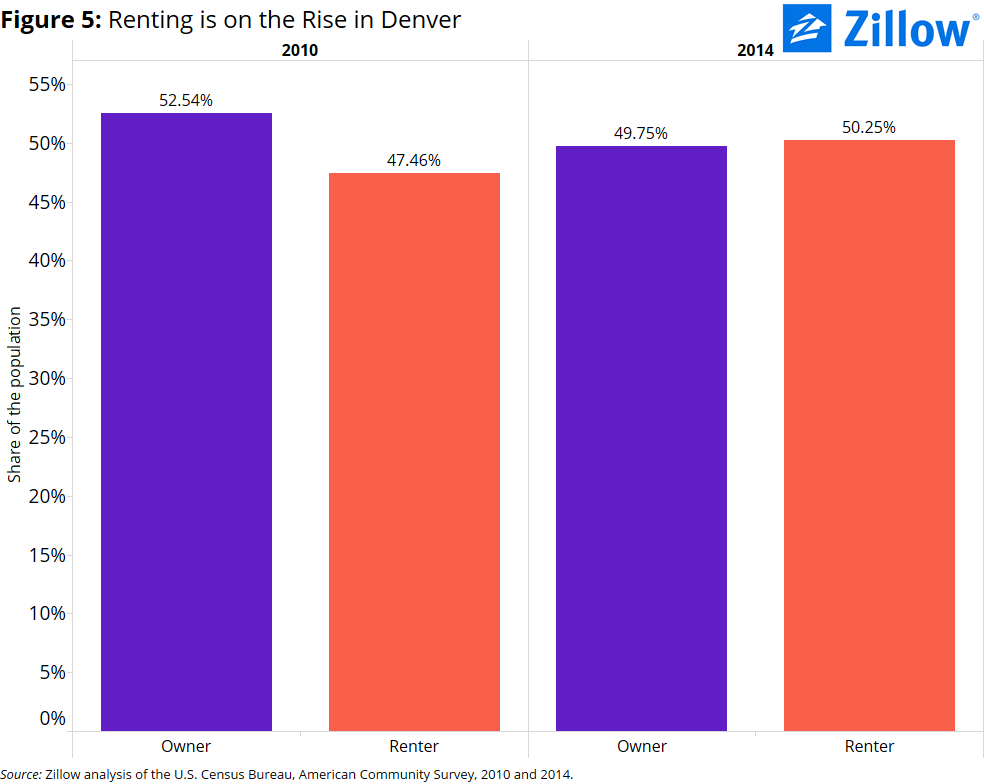 Becoming a majority-renter city on its own is nothing to be particularly alarmed at – many large American cities, including Boston, New York City and Washington, D.C., all have more renter households than homeowner households. But it is striking given the rapid deterioration in rental affordability in Denver.
Becoming a majority-renter city on its own is nothing to be particularly alarmed at – many large American cities, including Boston, New York City and Washington, D.C., all have more renter households than homeowner households. But it is striking given the rapid deterioration in rental affordability in Denver.
Between 1980 and 2000, typical renters in the city of Denver could reasonably expect to spend around 30 percent of their income on rent. By the end of 2014, that number had ballooned to 38.3 percent of their income, as rapid rental appreciation outpaced growth in wages. Homeowners in Denver, meanwhile, spent just 23.8 percent of their income on a mortgage payment for the typical home in 2014, more than historic norms around 21 percent, but still much less than a typical renter.
As Denver continues to evolve and attract new residents, it will likely struggle to maintain what housing affordability advantages it does hold relative to other large cities, for both current and new residents. As in many other cities that have experienced similar growth, like San Francisco and Seattle, it is important for the city to try to plan for the future and make sure that Denver remains an affordable and desirable place to live.
On March 30, Zillow will make Denver the seventh stop on its Housing Roadmap to 2016 tour of America, aimed at discussing housing challenges in the cities most impacted by them. Over the past decade, Denver has become one of America’s fastest-growing cities, with droves of new residents attracted by the city’s legendary beauty and quality of life, and its abundant job opportunities.
But growth does not come without growing pains, and Denver is not immune. Prior to our March 30 discussion, Zillow will publish new research detailing the factors driving Denver’s enviable growth, as well as some of the side effects.
We invite you to please tune in on March 30 to the live-streamed program at: http://www.zillow.com/housing-roadmap/denver
The program will begin at 12:45 PM MT/2:45 PM EST.
[1] The city of Denver and Denver County are coterminous (for local government purposes, the area is officially called the “City and County of Denver”), so even though data are on the county-level, we can talk about migration to and from the city by examining the migration patterns to and from Denver County, Colorado. IRS data on county-to-county migration patterns cover only households who could be identified and filed taxes in both 2012 and 2013. The data do not fully capture household transitions – for instance, following divorce or death – but remain the most comprehensive, publicly available data on domestic migration patterns within the United States. This analysis does not include international migrants nor domestic migrants for whom no county of origin is identified. Rent affordability by county is calculated using county-level Zillow Rent Index and Zillow Home Value Index data as of December 2013, and county-level median household incomes from the U.S. Census Bureau’s 2013 American Community Survey.





